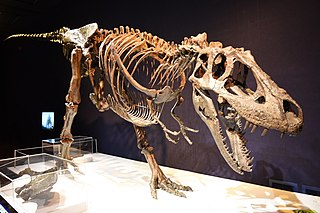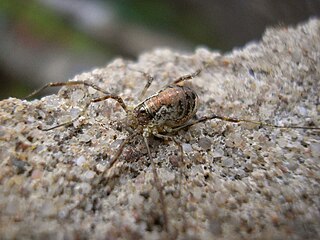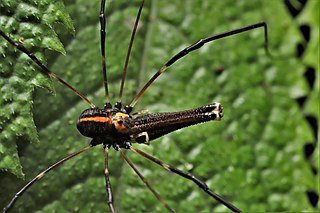
The Opiliones are an order of arachnids, colloquially known as harvestmen, harvesters, harvest spiders, or daddy longlegs. As of July 2024, over 6,650 species of harvestmen have been discovered worldwide, although the total number of extant species may exceed 10,000. The order Opiliones includes five suborders: Cyphophthalmi, Eupnoi, Dyspnoi, Laniatores, and Tetrophthalmi, which were named in 2014.

Daspletosaurus is a genus of tyrannosaurid dinosaur that lived in Laramidia between about 78 and 74.4 million years ago, during the Late Cretaceous Period. The genus Daspletosaurus contains three named species. Fossils of the earlier type species, D. torosus, have been found in Alberta, while fossils of a later species, D. horneri, have been found only in Montana. D. wilsoni has been suggested as an intermediate species between D. torosus and D. horneri that evolved through anagenesis, but this theory has been disputed by other researchers.

Dyspnoi is a suborder of harvestmen, currently comprising 43 extant genera and 356 extant species, although more species are expected to be described in the future. The eight families are currently grouped into three superfamilies: the Acropsopilionoidea, Ischyropsalidioidea, and Troguloidea.

Cyphophthalmi is a suborder of harvestmen, colloquially known as mite harvestmen. Cyphophthalmi comprises 36 genera, and more than two hundred described species. The six families are currently grouped into three infraorders: the Boreophthalmi, Scopulophthalmi, and Sternophthalmi.
Banksula melones is a species of harvestman in family Phalangodidae. It is endemic to caves along the Stanislaus River of California, United States.

Mitopus morio is a species of harvestman arachnid belonging to the family Phalangiidae.

Paroligolophus agrestis is a species of harvestman. It occurs in Europe, including the United Kingdom, and has been introduced to North America in the Pacific Northwest and Nova Scotia.

Sabacon is a genus of the monotypic harvestman family Sabaconidae, with 59 species.

Phalangium opilio is a species of harvestman belonging to the family Phalangiidae.

Troglosironidae is a family of harvestmen with seventeen described species in a single genus, Troglosiro, which is found on the island of New Caledonia, in the Pacific Ocean.

Texella reyesi is a rare species of arachnid known by the common name Bone Cave harvestman. It is endemic to Texas in the United States, where it lives in limestone caves in Travis and Williamson Counties. It is threatened by the loss of its habitat. It is a federally listed endangered species of the United States.
The Cokendolpher cave harvestman, Texella cokendolpheri, is a species of cave-living harvestman native to Bexar County, Texas. The original common name, the Robber Baron Cave harvestman, stemmed from the cave which the harvestman inhabits. The scientific name and the current common name honor the prominent arachnologist, James Cokendolpher, who identified the species. T. cokendolpheri is one of twenty-eight species within the North American harvestman genus Texella. The first formal description of the harvestman took place in 1992 and the species’ listing under the Endangered Species Act followed eight years later. Current threats to the species include habitat loss and interactions with invasive fire ants.

Imperator torosus, commonly known as the brawny bolete, is a species of bolete fungus in the family Boletaceae. It is native to southern Europe east to the Caucasus and Israel. It is generally associated with deciduous trees such as hornbeam, oak and beech in warm, dry locales. Although generally rare in Europe, it appears to be relatively common in Hungary. Appearing in summer and autumn on chalky soils, the stocky fruit bodies have an ochre cap up to 20 cm (8 in) across, yellow pores on the cap underside, and a wine-red to brown or blackish stipe up to 6–15 cm (2.4–5.9 in) long by 3–6 cm (1.2–2.4 in) wide. The pale yellow flesh changes to different colours when broken or bruised depending on age; younger mushrooms become reddish, and older ones additionally take on bluish tones.

Trogulus tricarinatus is a species of harvestman. It is found in Europe and North America.

Tetrophthalmi is an extinct suborder of Opiliones that had both median and lateral eyes. First described in 2014, it is known from two extinct species. Phylogenetic analysis suggests that this eye arrangement is the ancestral condition for harvestmen, placing Tetrophthalmi and Cyphophthalmi in a basal position within Opiliones.
The giant Laotian harvestman is the unofficial name for an as-yet undescribed species of Opiliones belonging to the family Sclerosomatidae. The species was discovered in April 2012 near a cave in the southern province of Khammouan, by Dr. Peter Jäger of the Senckenberg Research Institute in Frankfurt, Germany, whilst shooting a television documentary about the wildlife of Laos.

Forsteropsalis pureora is a species of long-legged harvestman in the family Neopilionidae. This species is endemic to New Zealand, found in the North Island. They are found in native forest, often resting on vegetation or stream banks.

Taracus marchingtoni is a genus of harvestman found in the lava caves of semi-arid and arid regions of central Oregon. It belongs to the family Taracidae and was first collected by Jean and Wilton Ivie in 1965 in Lava River Cave but not identified as a new species until collected by Neil Marchington of the Oregon High Desert Grotto in 2008. Its range is suspected to be the surrounding areas of Newberry Volcano. It has enlarged but thin chelicerae, typically equal to or longer than the entire length of the body, and in small-bodied males nearly three times as long. The harvestman is troglobiotic and has a predominantly white abdomen, black chelicerae, and highly reduced eye size. T. marchingtoni has been observed feeding on small troglophilic millipedes identified as Plumatyla humerosa of the Conotylidae family.

Forsteropsalis photophaga, also known as the glow-worm hunter, is a species of long-legged harvestman in the family Neopilionidae. This species is endemic to New Zealand, found in North Island caves in the vicinity of Waitomo. The name "photophaga" comes from their habit of feeding on the luminescent larvae, pupae, and adults of the New Zealand glow-worm Arachnocampa luminosa.

Trogulus is a genus of Opiliones in the family Trogulidae. Harvestmen in the genus have large, elongated and flattened bodies and a two-segmented tarsus segment on leg II, which distinguishes them from other genera in the family Trogulidae. The legs tend to be short compared to most harvestmen. External morphology tends to be very uniform across species in the genus, making differentiation of species difficult. Species occur in a range of habitats, but are most common in forests where their primary prey, snails, are abundant. Trogulus contains the largest known harvestman by body length, Trogulus torosus.














